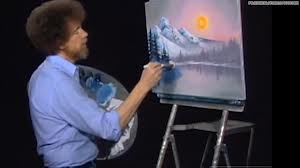For some reason I’ve always enjoyed watching episodes of Bob Ross’s “The Joy of Painting” when it airs on our local PBS station every Saturday morning. All this time I could never quite figure out why I found this show so interesting. Is it his 70’s era fro that could send the Brady Bunch into a fit of jealousy? Or is it his Hoosier-sounding accent that reminds me of some of my relatives? Or is it the peaceful way that he creates his art, allowing himself the freedom to make anything he wants in his world, happy trees, a mountain stream, a quiet meadow, in such an effortless way? He even says that line that I like so much “.. there are no mistakes, just happy accidents“. How cool is that? I should tattoo that across my forehead someday. If only my boss had the same philosophy about my work?
For so long I could never pin-point the real reason that I like to watch this show until it finally hit me one day. Much of the same mental process of visualization happens within my mind’s eyes & ears when producing a piece of music as it does in creating a painting.
If you think of songs as “audio paintings of sound” then you can gain some insights by watching how paintings come together. I’ve always tried to visualize my music in the same way, as if it is a painting in my mind that I’m trying to realize in sound.
- There is often a background image that supports everything else, and provides the context for the other elements of the painting
- There are supporting characters on top of that background image that add depth and interest, but are not the main focus
- Then there is a central element of the painting that is the main focus, that could stand alone as a separate painting but usually much more meaningful and interesting in the context of the background image and supporting characters
In Bob Ross’s world this might look like the following:
- Background: The horizon is painted in faded hues, gradually going from light to dark to mimic the sky meeting the horizon in the distance. Continue reading

